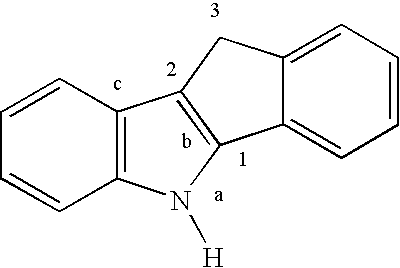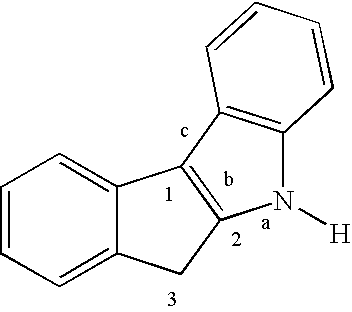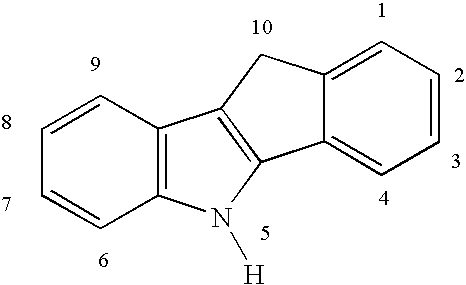Olefin polymerization process
a polymerization process and olefin technology, applied in the field of olefin polymerization process, can solve the problems of low activity and poor incorporation of -olefin comonomers, and achieve the effect of boosting catalyst activity and polyolefin molecular weigh
- Summary
- Abstract
- Description
- Claims
- Application Information
AI Technical Summary
Benefits of technology
Problems solved by technology
Method used
Image
Examples
example 1
Synthesis of 1,1-bis[6-(2,5-dimethyl-5,6-dihydro-indeno[2,1-b])indolyl]methane zirconium dichloride, 1-4
[0045]
[0046](a) Preparation of 5,6-dihydro-2-methyl-indeno[2,1-b]indole 1-1. A mixture of 2-indanone (51.0 g, 0.39 mol) and p-tolylhydrazine hydrochloride (61.4 g, 0.39 mol) is dissolved in glacial acetic acid (525 mL) and is vigorously stirred and heated to reflux. The mixture turns red and is heated for 2 hours. After cooling to room temperature, it is poured into ice water (1 L). The precipitate is filtered to afford a solid, which is washed with water (about 1 L). The solid is dissolved in ethyl acetate (1.4 L), activated charcoal is added, and the mixture is gently warmed. The mixture is then cooled and filtered over a pad of Celite. The filtrate is dried over sodium sulfate, filtered, and is then concentrated to 450 mL and cooled to −30° C. for 3 days. The crystalline solid is filtered and washed with chilled (−78° C.) hexanes (2×500 mL). The beige solid is collected and dri...
example 2
Preparation of Catalyst Supported on Diethylzinc-treated Silica
[0050]In a glove-box under nitrogen, 2.0 mL of 1.0 M diethylzinc in heptane is mixed with 2.00 g of G955 silica (available from Grace Davison) having a surface area (BET) of 280-355 m2 / g and a pore volume of 1.55-2.00 mL / g that had been calcined at 250° C. After mixing at room temperature for about 0.5 hour, volatiles are removed by vacuum to obtain 2.30 g of diethylzinc treated silica.
[0051]1.8 mL of 30% by weight methylalumoxane (MAO) in toluene is diluted by mixing with 3.6 mL toluene. Complex 1-4 (13.8 mg, 0.019 mmole) is mixed with the diluted MAO solution to make a deep green-blue solution. This green-blue solution is mixed further with 1.00 g of diethylzinc treated silica prepared above. After stirring for 30 minutes at room temperature, the volatiles are removed by vacuum to obtain 1.68 g of the supported catalyst as a dark green powder.
example 4
Copolymerization of Ethylene and 1-Hexene
[0053]Hydrogen is added (2.8 delta MPa from a 10-mL stainless-steel cylinder pressurized initially to 4.5 MPa H2) to a one-liter, stainless-steel reactor which is then charged with 1-hexene (10 mL). Triisobutylaluminum (0.5 mL of 1.0 M solution in heptane, 0.5 mmol) and Stadis fatty amine (12 mg, product of Akzo Nobel) in heptane solution (3.0 mL) are mixed in one sidearm of the injector. This mixture is then flushed into the reactor with nitrogen pressure and isobutane (about 400 mL) and then pressurized with ethylene to 2.4 MPa. The reactor contents are allowed to equilibrate at 80° C. The supported catalyst from Example 2 (29 mg) is loaded into the other injector arm and then flushed into the reactor with isobutane (90 mL) and nitrogen pressure. After 15 minutes, more hydrogen is added (2.8 delta MPa from a 10-mL stainless-steel cylinder pressurized initially to 4.5 MPa H2). The polymerization proceeds for another 15 minutes for a total of...
PUM
| Property | Measurement | Unit |
|---|---|---|
| temperature | aaaaa | aaaaa |
| particle size | aaaaa | aaaaa |
| particle size | aaaaa | aaaaa |
Abstract
Description
Claims
Application Information
 Login to View More
Login to View More - R&D
- Intellectual Property
- Life Sciences
- Materials
- Tech Scout
- Unparalleled Data Quality
- Higher Quality Content
- 60% Fewer Hallucinations
Browse by: Latest US Patents, China's latest patents, Technical Efficacy Thesaurus, Application Domain, Technology Topic, Popular Technical Reports.
© 2025 PatSnap. All rights reserved.Legal|Privacy policy|Modern Slavery Act Transparency Statement|Sitemap|About US| Contact US: help@patsnap.com



